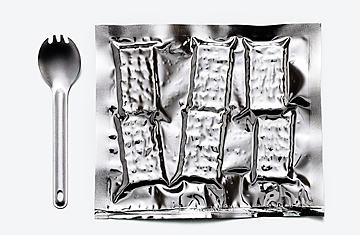
(3 of 3)
Oleksyk admits that these are still mostly dreams of the future, but researchers at NASA have also been pushing the boundaries of old-time heat treatment. A report published in December in the Journal of Food Science offered a detailed portrait of the outer limits of shelf stability for heat-treated, or thermostabilized, foods. The report was based on a three-year study of 13 foods, including vegetable side dishes (carrot coins, three-bean salad), pork chops, vegetable omelettes and apricot cobbler. Once processed and packaged, the foods were stored at Johnson Space Center and taste-tested on a regular basis over the three years. They remained edible for a surprising length of time, although they had clearly aged, turning darker and changing in texture. "We tested a tuna-fish casserole," says lead author Michele Perchonok, a food scientist at the center's Habitability and Environmental Factors Division. "The pasta got soft, but the tuna held up very well."
The best results consistently came from meat products, she says. For instance, extrapolating from its three-year study, the agency calculated that grilled pork chops could remain edible for nearly seven years and tuna or salmon for close to eight years (far longer than desserts, which had shelf lives of 1 to five years). She attributes the durability of meats mostly to their tough protein fibers.
Ultimately, long-lasting foods could have global impact. We rely on shelf-stable foods after disasters and when electricity fails. After Hurricane Katrina in 2005, many Gulf Coast residents subsisted on MREs provided by the military; these and similar products feed victims of everything from earthquakes and blizzards to drought. What's more, frozen- and chilled-food sections are expensive for grocers. In a future when energy supplies may be increasingly limited, researchers suggest, investment in food preservation looks like a smart move.
That's one of the main messages in a recent analysis titled "Feeding the World Today and Tomorrow" from the Chicago-based Institute of Food Technologists. The lead author, John Floros, head of the food-science department at Penn State University, says that without good food preservation, we could fall short of meeting the needs of a global population expected to top 7 billion this year. The problem, he says, is that we lose too much food to rot and decay. In developing countries without sophisticated food-distribution and cooling systems, the loss is consistently 30% a year and in some places as high as 70%. He expects such challenges to increase, along with uncertainties in food production related to projected global climate change. Floros works with NASA on its food-stability projects, but "we're not just talking about long-term space missions," he says flatly. "We're talking about survival here on earth."
Blum is a science writer and the author of The Poisoner's Handbook
Next: 6. Black Irony By Touré
